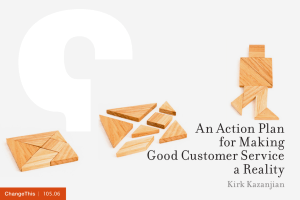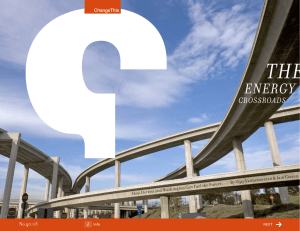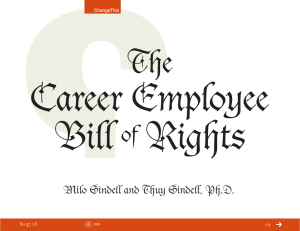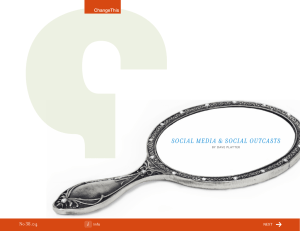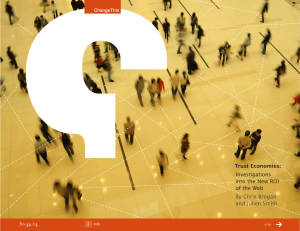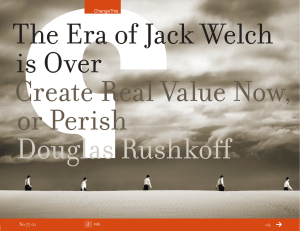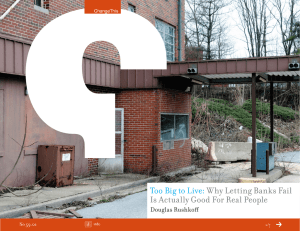DON’T BLOCK UP THE HALL LEIDY KLOTZ
advertisement
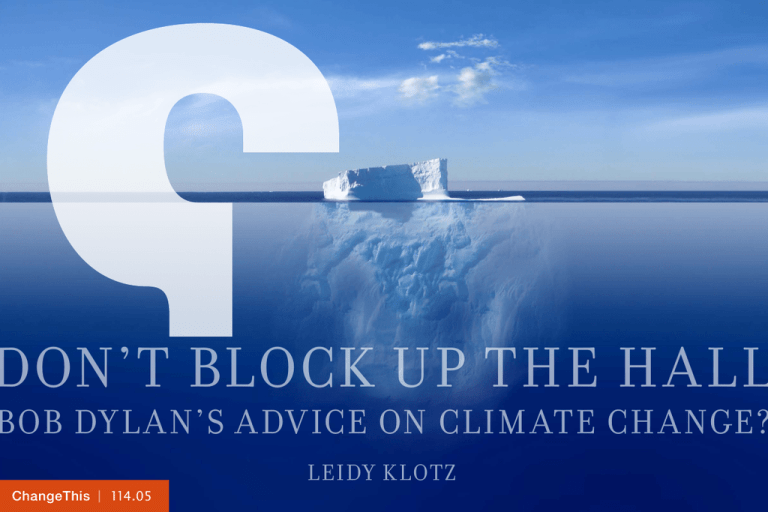
DON’T BLOCK UP THE HALL BOB DY L A N’S A DV ICE ON CLIM ATE CH A NGE? ChangeThis | 114.05 LEIDY K LOTZ Revolutionary ideas and actions, the type we need to prevent catastrophic climate change, often come from those who have not been socialized to outdated ways of doing things. Benizir Bhutto became the first woman Prime Minister of a Muslim country when she was just 35 years old. Thomas Jefferson wrote the Declaration of Independence at 33. Charles Darwin was only 29 when he first conceived his theory of natural selection. Harriet Tubman started the Underground Railroad at 28. Albert Einstein had his most groundbreaking year at 26, the same age at which Martin Luther King, Jr. led the Montgomery bus boycott. Isaac Newton was 23 when he saw the apple fall from the tree. Bill Gates and Steve Jobs were too young to rent cars when they founded Microsoft and Apple. You get the idea: those who topple outdated customs are unburdened by the excess conventional wisdom that can come with age. ChangeThis | 114.05 In perhaps his most influential civil rights era song, Bob Dylan asked senators and congressmen to “please heed the call.” Of course, help from those in power makes it easier to address any major societal issue. But Dylan went on to warn these leaders: “Don’t stand in the doorway, don’t block up the hall.” His sage advice to allow other, new contributions is now as relevant as ever. We must prevent catastrophic climate change, our new societal challenge—akin to those Dylan was singing about and King was meeting. We can do it, but only with new thinking… thinking that is currently shackled by the status-quo. We’re Fat and Getting Fatter I’m going to take for granted that, if you are reading this, you recognize climate change is here and that it’s a big deal. Luckily, it’s not an incurable disease. Climate change is more like obesity; we know what to do and we promise ourselves we’ll start eating better and working out—tomorrow. Our choice is not whether we should change to prevent climate catastrophe, it’s when. Acting now will require some sacrifice, no more all-you-can-eat fried food buffets. Or we can delay another generation, when hacking off limbs will look like a good weight-loss option compared with what we risk by doing nothing. ChangeThis | 114.05 Megastorms like Sandy and Katrina are canaries in the coal mine. And we can expect more sealevel rise, agriculture shifts, and permanent droughts, all of which displace populations and spark smoldering social instability. It doesn’t take a political scientist to predict frightening events when drought days double in a region where Libya, Egypt, and Sudan share a water supply. Despite knowing what needs to be done, and despite seeing initial effects of inaction, we just continue gorging. In the half century since scientists began expressing serious concern about global warming, energy use and the climate changing emissions that go with it have tripled. Our energy supply remains dominated by fossil fuels, which outnumber renewables more than 6 to 1, the same ratio as 20 years ago. Nearly all products claiming environmental benefits mislead consumers. New “green” buildings use more energy per square foot than buildings built 10, 50, and 100 years ago. The most popular automobile in 2007 couldn’t go as far on a gallon of gasoline as a 1908 Model T, and the number of automobiles continues to skyrocket. When it comes to energy and climate, we’re fat and getting fatter. “ We can do it, but only with new thinking… thinking that is currently shackled by the status-quo. ChangeThis | 114.05 The Solution? Pass the Buck to Young People We’re headed straight to climate catastrophe if we keep doing the same thing, even if we do more of it at a higher standard. We have to do something else, which is exactly what young people are good at. When he was 12, my neighbor Cortland suggested that sidewalks should be for cars and roads for people. Maybe “cars on sidewalks” is unreasonable, but “roads for people” makes a ton of sense when you think about it. Like Cortland, the college students I meet in my classes think differently, in a good way. Even those with civil engineering training don’t see adding highway lanes as the only way to reduce traffic and the accompanying fuel consumption (and stress). They ask “What about telecommuting?” They laugh at the absurdity of bigwigs who wear wool suits in the southern summer and then crank the air conditioning to stay comfortable. We need to pursue lots of changes along these lines and I’m not going to pretend to know what they all are. I do think social innovations, like acceptance of telecommuting, are at least as necessary as technical ones, like electric cars. I think we must avoid blind pursuit of growth when what we really want is prosperity. Collectively, I think young people can figure it out. The evidence backs me up. ChangeThis | 114.05 Certain skills peak when we are relatively young and diminish with age. Michael Jordan no longer plays in the NBA and the Rolling Stones aren’t the same in concert anymore. The decline with age is not just physical. Like our respiratory and immune systems, our capacity to solve new problems is thought to be a separate neural and mental system that tends to peak in young adulthood and declines with age. Cognitive processes, how the brain makes sense of information from the outside world, typically begin declining in our 20s, when memory and problem-solving abilities also stop growing. Reasoning ability is thought to peak at 28; even the youngest possible U.S. President would be seven years beyond max reasoning. Remember that these are all just trends, with many outliers. And other skills, including vocabulary and self-control, generally improve with age. Still, the average age of a new CEO is over 50 and more than 200 members of Congress are old enough to qualify for Social Security benefits. Maybe we shouldn’t be surprised by their inability to meet our climate challenges and obligations. “ We’re headed straight to climate catastrophe if we keep doing the same thing, even if we do more of it at a higher standard. We have to do something else, which is exactly what young people are good at. ChangeThis | 114.05 Ladder-Holders and Living Martyrs: How To Help If You’re Not Young New ideas always accompany generational shifts, but our climate obligations can’t wait. In the time it typically takes a new graduate to reach a leadership position, our economy and population could easily have doubled and our climate catastrophe will be devastating. So make paths for the best young people to rapidly reach positions of influence. Practice tolerance when young people take different actions from the ones you would have. Avoid over-managing and over-“educating” those who already possess a unique mentality to spur positive change. Our climate obligations require their new perspective, unspoiled by the “because that’s the way we’ve always done it” attitude. This probably goes against your basic nurturing and protective instincts. Even my Dad, the finest Father anyone could hope for, still insists that he climb the ladder and I hold it. Of course you care deeply for the next generation. They were read to in the womb, socialized at select preschools, and given toys designed to promote their development. Many were supported with the best elementary schools, out-of-school tutoring and educational camps, and incentives for doing well on standardized tests. They got help finding the right college and the benefit of remortgaged homes and delayed retirement savings to send them there. So far, so good. ChangeThis | 114.05 Yet, now that they are ready to repay these debts, they are smashing into a brick wall. They can fight in wars before they can run for elected office. 20-24-year-olds are unemployed at twice the rate of those over 55. We’re wasting our investments in youth if we don’t enable and support their decisions. Older people still have to heed the call and play a key role. It’s just that they should do more holding of the ladder and less standing on it. We need their accumulated experience and wisdom. While certain skills peak early in life and then diminish, many others are like a fine wine, improving with age. And certainly not every young person is ready to influence the path-shifting changes needed. I love working with college students, but there are a lot of underachievers and wanderers who, like me, need a few years (or decades) to mature. Every generation has its slackers, but compared to their predecessors our best and brightest youth know much more about how to meet our climate obligations. Plus, they want to apply this knowledge to make the world a better place. Alternative spring breaks, where students spend their vacation week helping those less fortunate, are increasingly popular, when just a decade ago it seems like everyone (my friends and me included) went to Daytona Beach or Miami. Brandon is one of my favorite examples of this new generation. ChangeThis | 114.05 A big, bearded young man who usually came to class wearing cowboy boots, a hunting jacket, and bloodshot eyes from the previous night’s activities, Brandon told me in our first conversation: “Look, I’m a redneck Republican from the South, but I understand the importance of this stuff.” For young people like Brandon, addressing climate change is not an environmental debate, it’s a societal obligation. If, like my Dad, you want to do more than hold the ladder, a fun way to help young people meet our climate obligations is as a living climate martyr. Are you close to retirement? Financially secure? Use your freedom from necessity to go out in a blaze of glory. James Hansen is one such living climate martyr. Hansen had a decorated career as a climate scientist, earning himself admission into the prestigious National Academy of Sciences in 1994. In his second phase of life, he works to help others recognize the urgent need for action. Now in his 70s, Hansen is an activist with proud accomplishments that include four arrests (so far) for protesting activities leading to climate change. Hansen follows in the footsteps of other “old” people whose revolutionary actions we’re still talking about today. Mohandas Gandhi, at 73, led the civil disobedience movement that gave India independence. In the build-up to the Civil War, 59-year-old abolitionist John Brown started a slave uprising with a raid on Harpers Ferry, Virginia. Our climate obligations don’t require killing anyone like Brown; we probably don’t even need Gandhian hunger strikes. But, if you want to live forever in the minds of others, serving as a living climate martyr is your chance. ChangeThis | 114.05 Our Peaceful Revolution Before becoming infested with too much so-called “expertise” or cynicism, young people must act. Thanks to those who have come before, you need not spend your valuable time taking ice cores; you can study the science and act on that knowledge. Thomas Jefferson thought that each new generation should have its own revolution, that this is the price of freedom. Imagine Jefferson facing our climate obligations, especially when most entrenched interests are either delaying serious action or still adding fuel to the fire. I think he would be challenging this status-quo and encouraging us to do the same. He certainly wouldn’t be waiting for those who made a fortune digging us into this hole to lead us out of it. The climate revolution is more likely to be peaceful the sooner it starts. Don’t wait for someone to make room for you. People have a tendency to hold onto torches rather than pass them. If you think you’re onto something better, trust your instincts. Many leverage points are accessible without being in a position of power, so figure out a specific action you can take right away. “ Before becoming infested with too much so-called “expertise” or cynicism, young people must act. ChangeThis | 114.05 Of course, just being young and confident is not enough to meet our climate obligations. Einstein, Jefferson, King, Tubman, and others all combined youth with a tenacious work ethic. Young people today must do the same. Develop your broad systems-thinking skills. Take relevant classes and pursue opportunities for hands-on practice and organizing on your campus, in your community, and beyond. Learn about the fundamentals in your field and how they relate to our climate obligations. The youthful climate revolution is not yet in full swing, but it’s not starting from scratch either. Bright spots are everywhere; they just need to be expanded. Members of Powershift, which fights for a clean energy future, are occupying city centers and college presidents’ offices to protest expanded use of especially damaging fossil fuels. They are also lobbying and participating in leading climate conferences. Over 10,000 young leaders attended their two-day bootcamp in 2011. Netimpact, a group of students using the power of business to create a more sustainable world, has over 20,000 members. Faith-based groups are also on board. The Catholic Coalition on Climate Change published a toolkit for catholic universities and colleges pursuing climate initiatives. The list goes on. Frat boys at exclusive private schools like the University of Chicago and large public schools like the University of Maryland are planning parties that encourage reuse, recycling, and carpooling. ChangeThis | 114.05 Bright spots like these haven’t yet reached the scale needed to influence fundamental change. But it took less than 50 years to go from the Wright brothers’ short flight on the Kitty Hawk sand dunes to a jet traveling at the speed of sound. And just as we scale-up technology, we’re also good at changing mindsets. How have your opinions on gay rights evolved over the past 20 years? Every day I witness the innovation, skill, and sheer determination of young people as they re-think the status quo. They should not be forced to take a backseat just because of age or experience, especially when our climate obligations require new thinking and action. Like our parents and grandparents, we all want to do our part to build a better future. Young people are not only our best motivation for pursuing this better future, they are our best shot at creating it. ChangeThis | 114.05 Info ABOUT THE AUTHOR | Leidy Klotz does not have a book to sell, which is good because he’s not a very graceful writer. Fortunately, as an engineering professor, he has another source of income and can share ideas like this one by writing early in the morning and on weekends. Leidy developed and teaches courses in Sustainable Energy Innovation and does research on related topics. He has received awards for both his teaching and research (awards are often given as an alternative to raises). Before becoming an academic, Leidy worked managing school construction projects in New Jersey. Before getting a real job, he played for the Pittsburgh Riverhounds professional soccer team in 2000 and 2001. Leidy and his wife, Monica, live in Clemson, SC where most of their climate-changing emissions come from travel to visit family or the beach. ➔ SEND THIS | Pass along a copy of this manifesto to others. ➔ SUBSCRIBE | Sign up for e-news to learn when our latest manifestos are available. This document was created on February 19, 2014 and is based on the best information available at that time. The copyright of this work belongs to the author, who is solely responsible for the content. This work is licensed under the Creative Commons Attribution-NonCommercial-NoDerivs License. To view a copy of this license, visit Creative Commons or send a letter to Creative Commons, 559 Nathan Abbott Way, Stanford, California 94305, USA. Cover image from Veer. You are given the unlimited right to print this manifesto and to distribute it electronically (via email, your website, or any other means). You can print out pages and put them in your favorite coffee shop’s windows or your doctor’s waiting room. You can transcribe the author’s words onto the sidewalk, or you can hand out copies to everyone you meet. You may not alter this manifesto in any way, though, and you may not charge for it. ChangeThis | 114.05 About ChangeThis ChangeThis is a vehicle, not a publisher. We make it easy for big ideas to spread. While the authors we work with are responsible for their own work, they don’t necessarily agree with everything available in ChangeThis format. But you knew that already. ChangeThis is supported by the love and tender care of 800-CEO-READ. Visit us at 800-CEO-READ or at our daily blog. Explore your knowledge further with KnowledgeBlocks, a new project from 800-CEO-READ that lets you turn what you know into knowledge you can use. ChangeThis | 114.05
